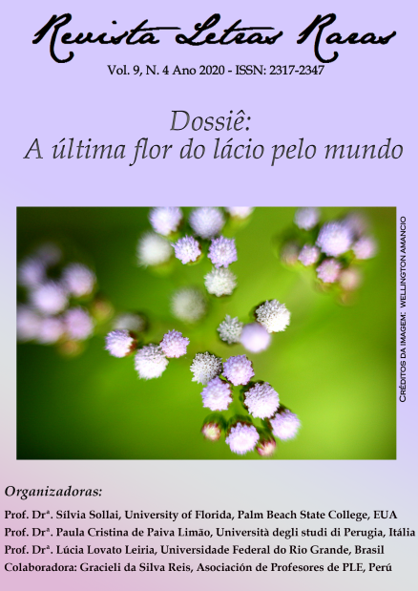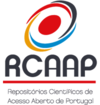O caleidoscópio pluricêntrico: um estudo de caso de corpora em português língua crítica e variantes lusófonas
Palabras clave:
Pluricentrismo, Línguas críticas, Competência global, Habilidade intercultural e holística relacionável, AutenticidadeResumen
DOI: https://dx.doi.org/10.35572/rlr.v9i4.1943
Enquanto o pluricentrismo vem se tornando um componente central no ensino de Português como Língua Estrangeira (PLE), há um debate paralelo sobre a representação de vozes periféricas para línguas críticas, especialmente no que tange a competência global. Ou seja, a literatura pertinente demonstra que línguas menos comumente ensinadas nos Estados Unidos, como PLE e suas variantes lusófonas, devem ser inclusivas e equilibradas com habilidade intercultural e holística relacionável (NUGENT; SLATER, 2017). Este estudo explora como o acesso à autenticidade, fonte inalterada e integral, na Internet reflete a natureza pluricêntrica do português. A triangulação de dados oriundos de vídeos revela uma deficiência decrescente na formação do professor, desde a definição do público-alvo até o alinhamento do conteúdo instrucional. Os resultados também confirmam as descobertas e implicações que apontam para a necessidade de medidas além do nível distrital para que o português seja reconhecido como língua para comunicação internacional (MENDES, 2014).
Descargas
Citas
ACTFL, J. Proficiency guidelines 2012. Alexandria, VA: American Council on the Teaching of Foreign Languages, 2012. Available at: [https://www.actfl.org/resources/actfl-proficiency-guidelines-2012]. Access on: Sep 1, 2020.
ALMOR, A., DE CARVALHO MAIA, J., LIMA, M. L. C., VERNICE, M. & GELORMINI-LEZAMA, C. Language processing, acceptability, and statistical distribution: a study of null and overt subjects in Brazilian Portuguese. Journal of Memory and Language, London, v. 92, 2017, p. 98-113. Available at: [https://www.sciencedirect.com/science/article/pii/S0749596X16300468]. Accessed on: Aug 27, 2020.
AMMON, U. Pluricentric and divided languages. In: AMMON, U. et al. (Eds.). An international handbook of the science of language and society, 2ed., Berlin: WALTER DE GRUYTER, 2005, p. 1536-1543.
BATORÉO, H. Que gramática (s) temos para estudar o português língua pluricêntrica? Diadorim Revista de Estudos Linguísticos e Literários, Rio de Janeiro: Universidade Federal do Rio de Janeiro, v. 16, 2014, p. 01-15.
BATORÉO, H. J. & CASADINHO, M. O Português – uma língua pluricêntrica: o caso de Timor-Leste. Revista Portuguesa de Humanidades, Estudos Linguísticos, Braga: Universidade Católica de Braga, v. 13, n.1, 2009, p. 63-79.
BATEMAN, B. Communication and other c’s: a study of what Portuguese instructors want in textbooks. Portuguese Language Journal, Gainesville, FL: University of Florida, v. 8, 2014, p. 1-31. Available at < http://www.ensinoportugues.org/wp-content/uploads/2014/10/What-Portuguese-Instructors-Want-in-Textbooks-final1.pdf>
BAXTER, A. N. Portuguese as a pluricentric language. In: CLYNE, M. (Ed.). Pluricentric languages: differing norms in different nations. Berlin: WALTER DE GRUYTER, 1992, p. 11-23.
BERARDO, S. A. The use of authentic materials in the teaching of reading. The Reading Matrix, Long Beach, CA: Long Beach City College, v.6, n. 2, 2006, p. 60-69. Available at: [http://www.readingmatrix.com/articles/berardo/article.pdf]. Accessed on: Aug 30, 2020.
CABECINHAS, R. Representações sociais da história nacional. Estudos comparativos em contexto lusófono. In MARTINS, M. L. (Ed.). Lusofonia e interculturalidade – promessa e travessia. Vila Nova de Famalicão: HÚMUS, 2015, p. 335-354. Available at: [http://repositorium.sdum.uminho.pt/bitstream/1822/39713/1/RC_lusofonia_interculturalidade.pdf]. Accessed on Aug 27, 2020.
CLYNE, M. (Ed.). Pluricentric languages: differing norms in different nations. Berlin: WALTER DE GRUYTER, 1992.
CAHEN, M. What good is Portugal to an African. In: LLOYD-JONES, S. & COSTA PINTO, A. The last empire: thirty years of Portuguese decolonization. Bristol, UK: INTELLECT BOOKS, 2003, p. 83-98.
CALIFORNIA LANGUAGE TEACHERS’ ASSOCIATION. SB 5 Karnett Bill of 2005. California World Language Content Standards for Public Schools K-12, 2019. Available at: [https://clta.net/advocacy/standards/]. Accessed on: Aug 27, 2020.
CRESWELL, J. W. Research design: qualitative, quantitative, and mixed methods approaches. London, UK: SAGE, 2013.
DA SILVA, A. S. (Ed.). Pluricentricity: language variation and sociocognitive dimensions. Berlin: DE GRUYTER, 2014.
DA SILVA, J. F. & GUNNEWIEK, L. K. Portuguese and Brazilian efforts to spread Portuguese. International Journal of the Sociology of Language, Berlin: DE GRUYTER MOUTON, v. 95, n. 1, 1992, p. 71-92.
EISEN, S. The language flagship model and the humanities. Russian Language Journal, Washington, D.C.: AMERICAN COUNCILS FOR INTERNATIONAL EDUCATION, v. 64, 2014, p. 5-24.
ENGEL, L. C., FUNDALINSKI, J., & CANNON, T. Global citizenship education at a local level: a comparative analysis of four US urban districts. Revista Española de Educación Comparada, v. 28, 2016, p. 23-51.
FERREIRA, F. & GONTIJO, V. Why, who and where? Portuguese language learners and types of motivation. Portuguese Language Journal, Gainesville, FL: University of Florida, v. 5, 2011, p. 1-30. Available at [http://www.ensinoportugues.org/wp-content/uploads/2011/05/Ferreira.pdf]. Accessed on: Aug 18, 2020.
GUARIENTO, W., & MORLEY, J. Text and task authenticity in the EFL classroom. ELT Journal, Oxford University Press, v. 55, n. 4, 2001, p. 347-353.
GILMORE, A. Authentic materials and authenticity in foreign language learning. Language teaching, Cambridge University Press, v. 40, n. 2, 2007, p. 97-118.
GOGLIA, F., & AFONSO, S. Multilingualism and language maintenance in the East Timorese diaspora in Portugal. Journal of Lusophone Studies, Stanford, CA: American Portuguese Studies Association, v.10, 2012.
JOHNSON, B. & CHRISTENSEN, L. Educational research: quantitative, qualitative, and mixed approaches. London, UK: SAGE, 2008.
JOUËT-PASTRÉ, C. Mapping the world of the heritage language learners of Portuguese: results from a national survey at the college level. Portuguese Language Journal, Gainesville, FL: University of Florida, v. 5, 2011, p. 1-27. Available at [http://www.ensinoportugues.org/wp-content/uploads/2011/05/Clemence-revised-10-6-11.pdf]. Accessed on: Aug 29, 2020.
KOURY, M. G. P. Identidade e pertença: disposições morais e disciplinares em um grupo de jovens. Revista do Centro em Rede de Investigação em Antropologia, Portugal: Etnográfica, v. 14, n. 1, 2010, p. 27-58.
LUEDI, G. (2012). Traces of monolingual and plurilingual ideologies in the history of language policies in France. In: HÜNING, M., VOGL, U., & MOLINER, O. (Eds.). Standard languages and multilingualism in European history, Amsterdam: JOHN BENJAMINS PUBLISHING, 2012, p. 205-230.
MACQUEEN, N. A community of illusions? Portugal, the CPLP and peacemaking in Guiné-Bissau. International Peacekeeping, London, UK: TAYLOR & FRANCIS, v.10, n.2, 2003, p. 2-26.
MITTELSTADT, D. D., SCHOFFEN, J. R. & SCHLATTER, M. Culture and diversity in the teaching of Portuguese as additional language. BELT- Brazilian English Language Teaching Journal, Porto Alegre, RS: PUCRS, 2019, v. 10, n. 1, p. e34390-e34390. Available at: [https://revistaseletronicas.pucrs.br/index.php/belt/article/download/34390/18144]. Accessed on: Sep 2, 2020.
MENDES, E. A ideia de cultura e sua atualidade para o ensino-aprendizagem de LE/L2. Revista Entre Línguas, v. 1, n. 2, 2015, p. 203-222. Available at: [https://periodicos.fclar.unesp.br/entrelinguas/article/download/8060/5489]. Accessed on: Sep 1, 2020.
MENDES, E. O Ensino do Português como Língua Estrangeira (PLE): Desafios, Tendências Contemporâneas e Políticas Institucionais. In: ANDREEVA, Y. (Org.). Horizontes do saber filológico. Sófia-Bulgária: SVETI KLIMENT OHRIDSKI, 2014, p. 33-45.
MOREIRA E SILVA, L. H. Unidade e diversidade: os sentidos do idioma nos estudos sobre a língua portuguesa. In: VI Seminário de estudos em análise do discurso, 2013. Available at: [http://analisedodiscurso.ufrgs.br/anaisdosead/6SEAD/PAINEIS/UnidadeEDiversidade.pdf]. Accessed on: Sep 1, 2020.
MUHR, R. (Org.). Non-dominant varieties of pluricentric languages: getting the picture. Peter Lang. In: 1st International conference on non-dominating varieties of pluricentric languages. Graz, Austria: OEDT, 2012.
MUHR, R. & MARLEY, D. in collaboration with Kretzenbacher, H. L. & Bissoonauth, A. (Eds.) Pluricentric languages: New perspectives in theory and description. Bern: PETER LANG, 2015.
NEVES, M. H. M. O acordo ortográfico da língua portuguesa e a meta de simplificação e unificação. DELTA: Documentação de Estudos em Lingüística Teórica e Aplicada, v. 26, n. 1, 2010, p. 87-113.
NUGENT, M. & SLATER, R. The language flagship: creating expectations and opportunities for professional-level language learning in undergraduate education. In: MURPHY, D. & EVANS-ROMAINE, K. Exploring the US Language Flagship program: Professional competence in a second language by graduation. Bristol, UK: Multilingual Matters, 2017, p. 9-28.
OLIVEIRA, G. M. D. Política linguística e internacionalização: a língua portuguesa no mundo globalizado do século XXI. Trabalhos em Linguística Aplicada, Campinas: UNICAMP, v. 52, n. 2, 2013, p. 409-433. Available at: [https://www.scielo.br/scielo.php?pid=S0103-18132013000200010&script=sci_arttext&tlng=pt]. Accessed on: Aug 23, 2020.
RAMOS-SOLLAI, S., ALVIM, R., BIANCONI, C. & FEBRAIO PARMA, A. Portuguese is in! Revista Todas as Letras, v. 20, n. 1, 2018, p. 105-121.
RAMOS-SOLLAI, S. R. Além do aprendizado da cultura brasileira: recorte sobre a tolerância à ambiguidade cultural em estudos de caso de PL2 e PLE. Revista Vozes dos Vales Universidade Federal dos Vales do Jequitinhonha e Mucuri, Minas Gerais: UFVJM, n. 4, 2013, p. 1-19. Available at: [http://site.ufvjm.edu.br/revistamultidisciplinar/files/2011/09/Além-do-aprendizado-da-cultura-brasileira-USA.pdf]. Accessed on: Sep 10, 2020.
REIS, L. Implicações do conceito de língua pluricêntrica para a promoção do Português e para o processo de ensino-aprendizagem de PLE-PL2. In: GONÇALVES, L. (Org.). O Ensino de português como língua estrangeira – reflexões sobre a prática pedagógica. American Organization of Teachers of Portuguese (AOTP). New Jersey: BOAVISTA, 2015, p. 15-27.
SANTOS, D. Português internacional: alguns argumentos. In: TEIXEIRA, J. (ed.). O Português como língua num mundo global: problemas e potencialidade. Centro de Estudos Lusíadas da Universidade do Minho, 2016, p. 51-68.
SARDINHA, T. B. & FERREIRA, T. D. L. S. B. (Eds.). Working with Portuguese Corpora. 1ed. London, UK: BLOOMSBURY, 2014.
SOARES DA SILVA, A. Convergence et divergence entre le Portugais européen et le Portugais du Brésil: un projet de sociolexicologie cognitive. In: ILIESCU, M., SILLER-RUNGGALDIER, H. M. & DANLER, P. (Eds.). Actes du XXVe Congrès International de Linguistique et de Philologie Romanes, Tome IV, Section X, Sociolinguistique et dialectologie. Berlin: DE GRUYTER, 2010, p. 243-256.
SOLLAI, S. & PARMA, A. As línguas portuguesas do mundo: Representações pluricêntricas de Português Língua Estrangeira (PLE) numa amostra de material didático. Hispania, John Hopkins University Press, v. 101, n. 2, 2018, p. 237-248. Available at: [https://www.researchgate.net/profile/Silvia_Sollai2/publication/325679430_As_linguas_portuguesas_do_mundo_Representacoes_pluricentricas_de_Portugues_Lingua_Estrangeira_PLE_numa_amostra_de_material_didatico/links/5c98494492851cf0ae95ec72/As-linguas-portuguesas-do-mundo-Representacoes-pluricentricas-de-Portugues-Lingua-Estrangeira-PLE-numa-amostra-de-material-didatico.pdf]. Accessed on: Aug 28, 2020.
VALDEZ, M. T. T. (2011). A Representação da Cultura de uma Língua Minoritária: Manuais de Português em França. Portuguese Language Journal, Gainesville, FL: University of Florida, v. 5, 2011, p. 1-21. Available at [http://www.ensinoportugues.org/wp-content/uploads/2011/05/Valdez.pdf]. Accessed on: Aug 28, 2020.
ZAMPIERI, M. & GEBRE, B. G. Automatic identification of language varieties: The case of Portuguese. In: KONVENS2012 - The 11th Conference on Natural Language Processing 2012, p. 233-237. Österreichischen Gesellschaft für Artificial Intelligende (ÖGAI).
ZOPPI-FONTANA, M. G. & DINIZ, L. R. Declinando a língua pelas injunções do mercado: institucionalização do português língua estrangeira (PLE). Estudos Linguísticos, v. 37, n. 3, 2008, p. 89-119.
Publicado
Cómo citar
Número
Sección
Licencia
Derechos de autor 2023 Revista Letras Raras

Esta obra está bajo una licencia internacional Creative Commons Atribución-NoComercial 4.0.








